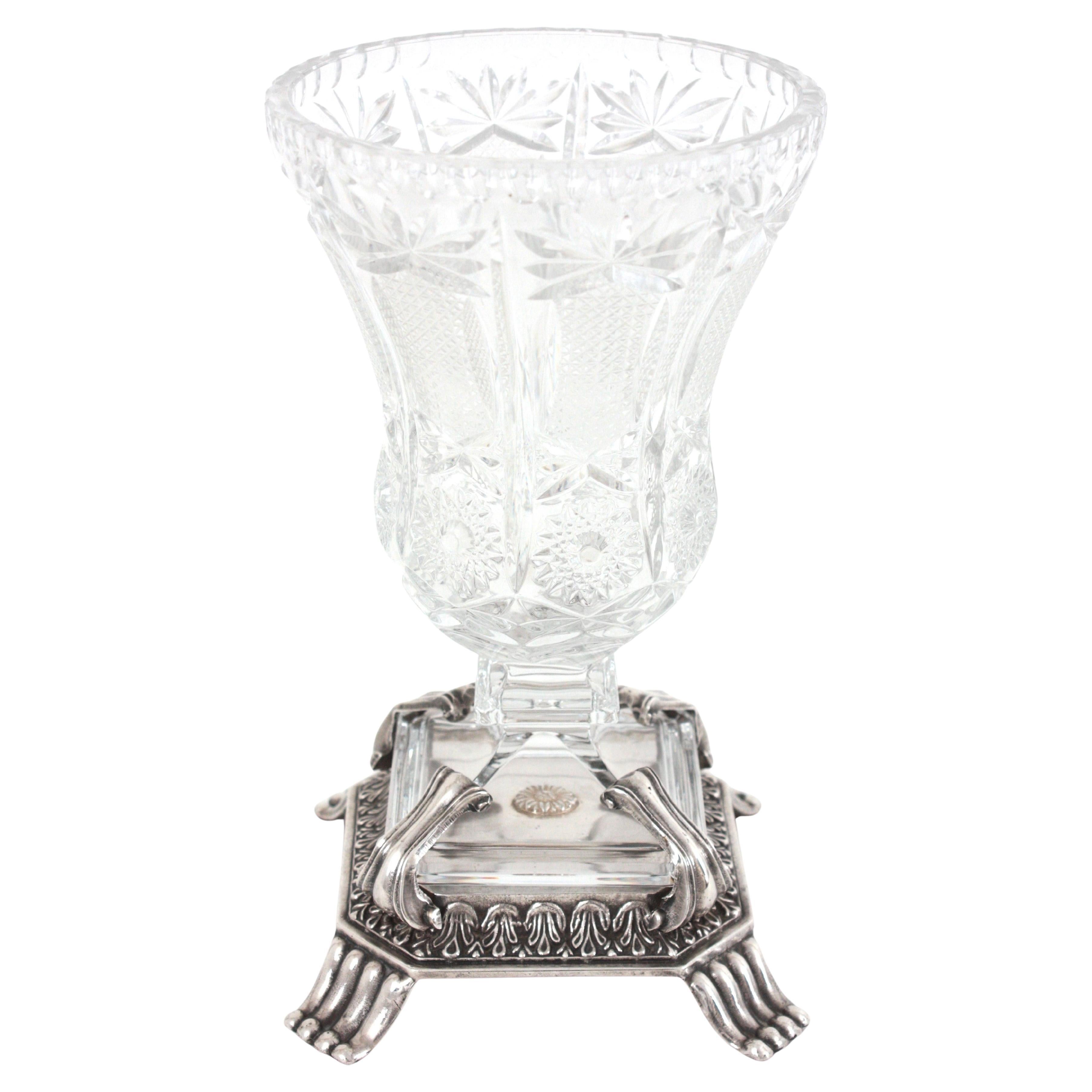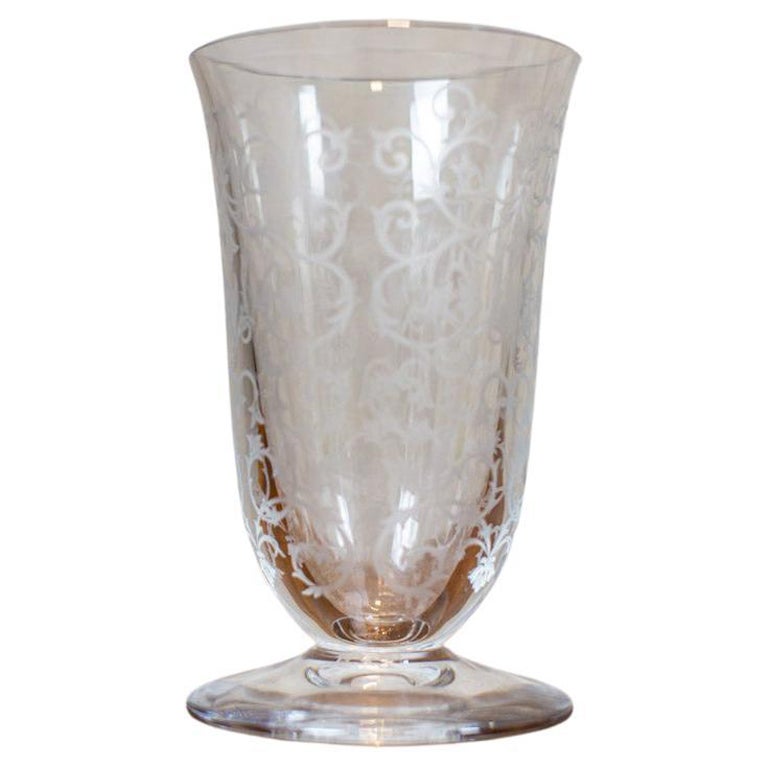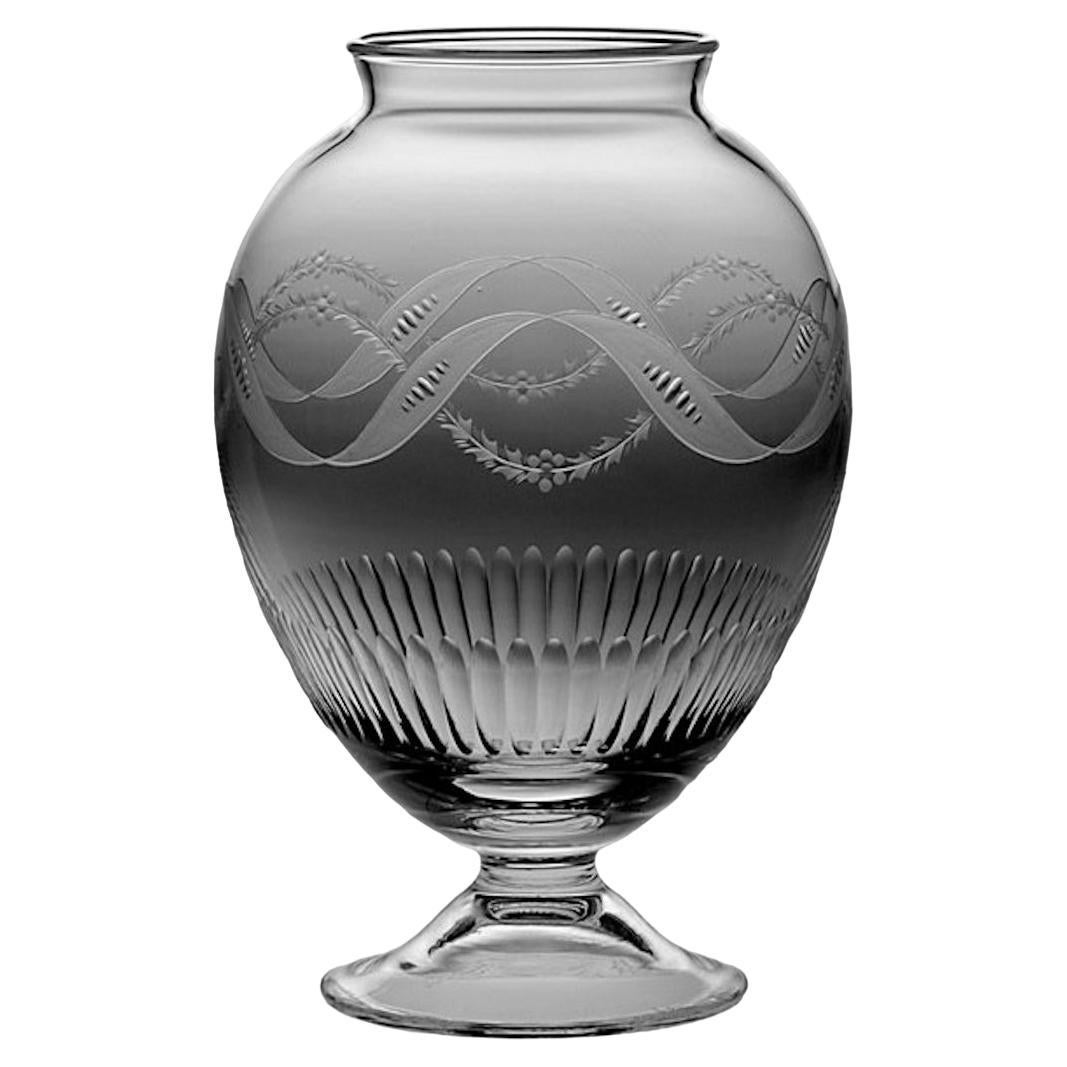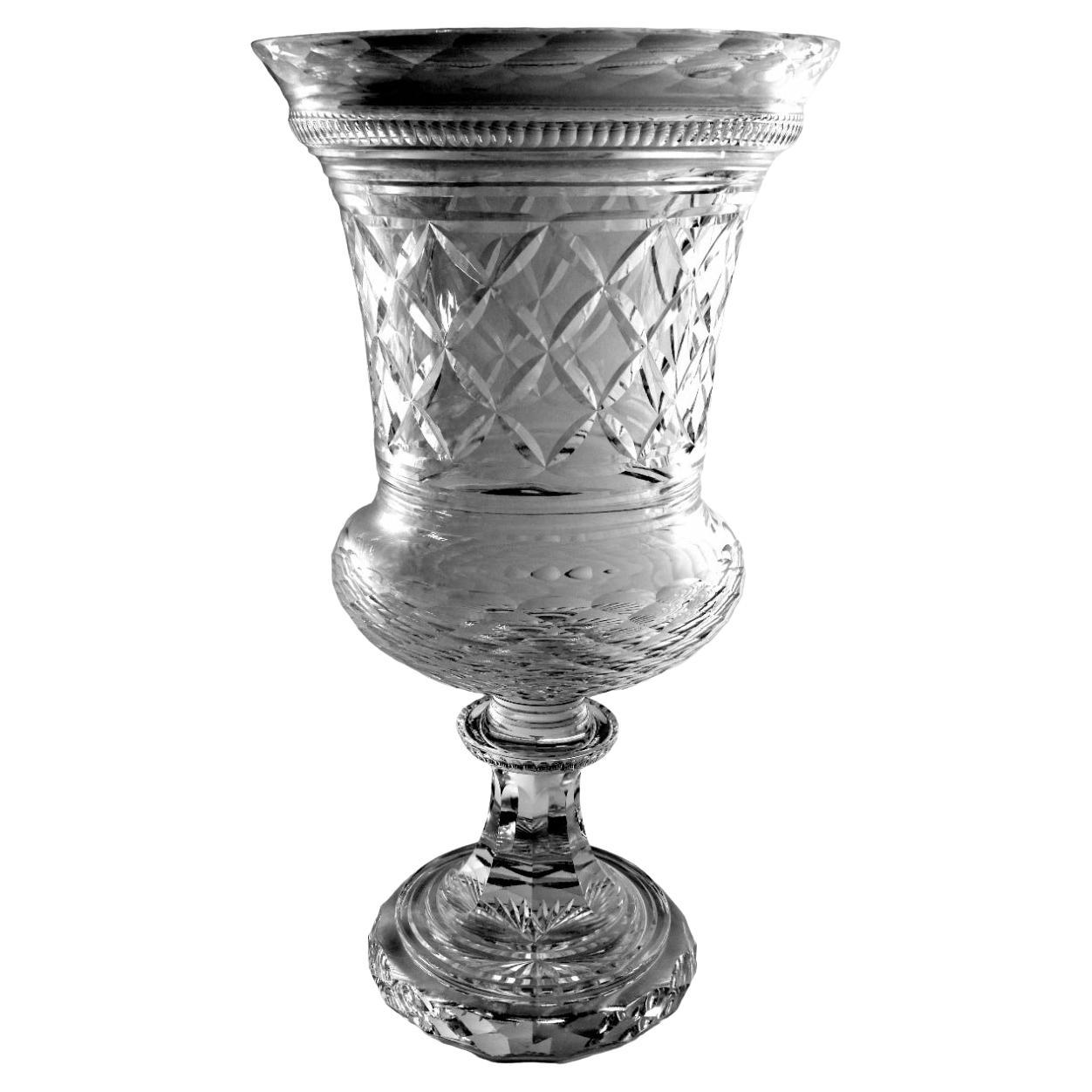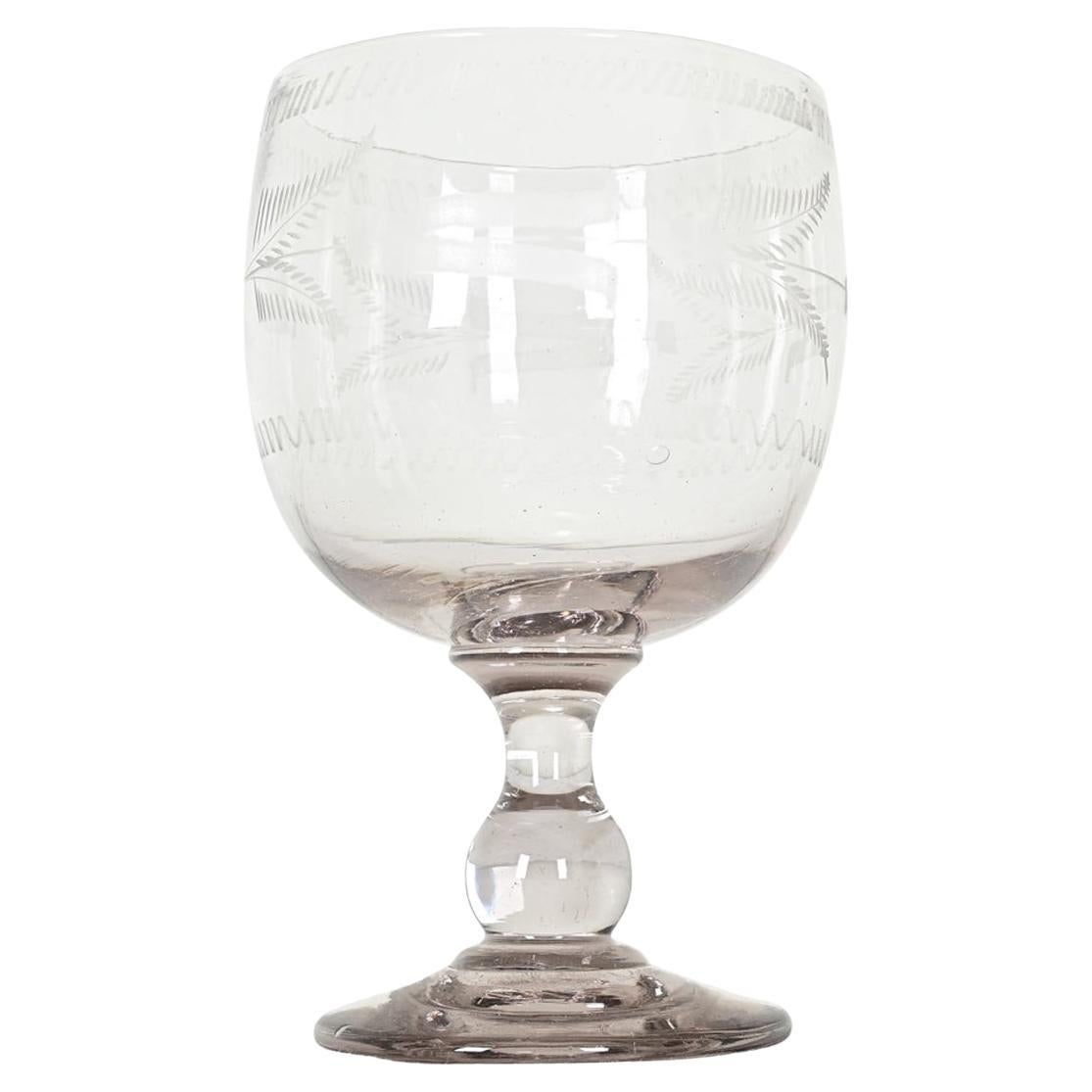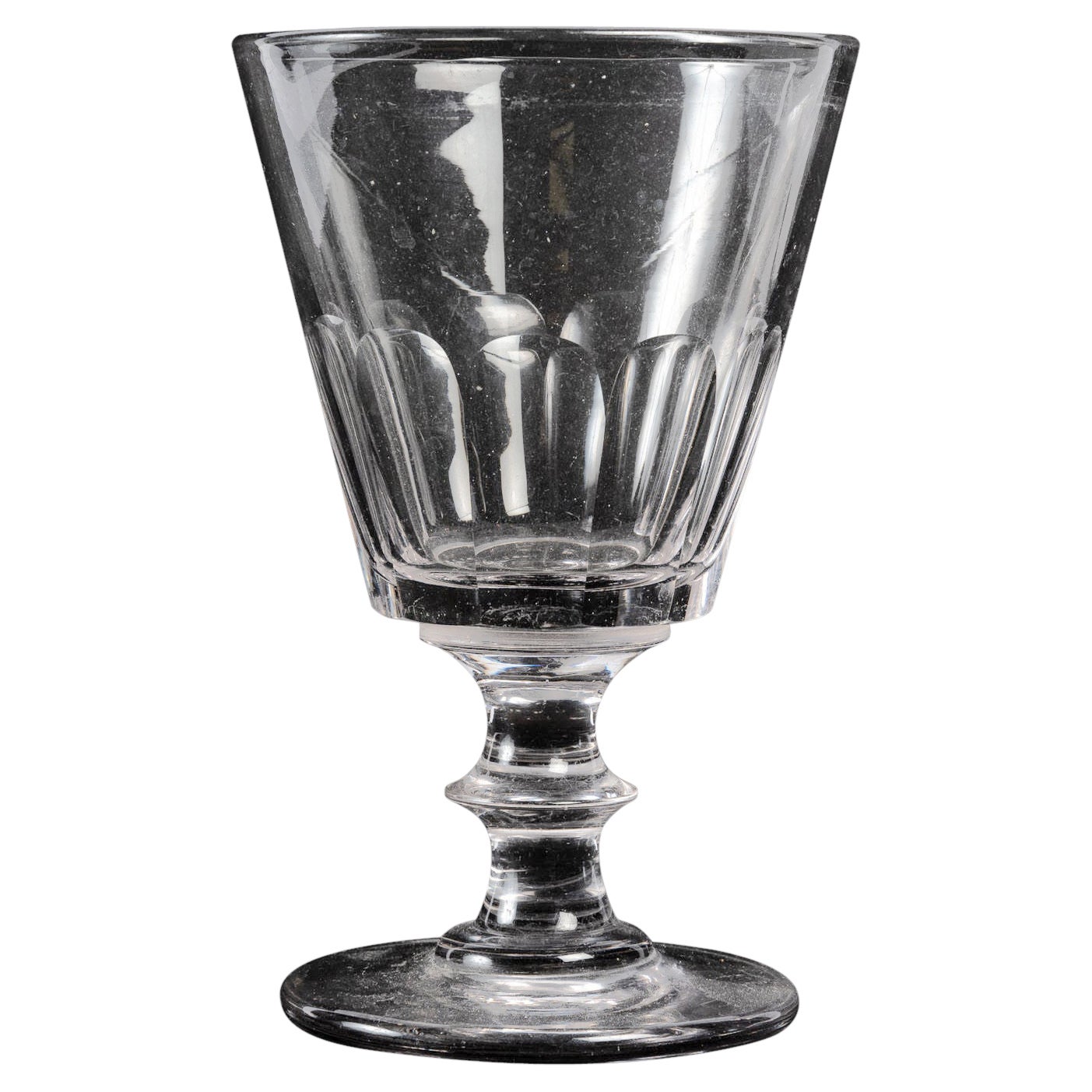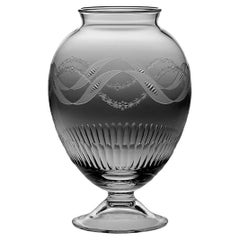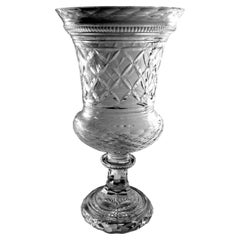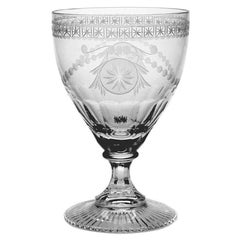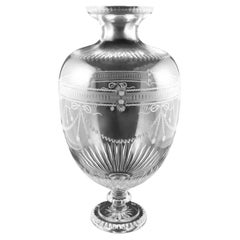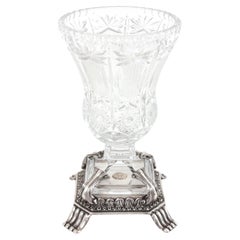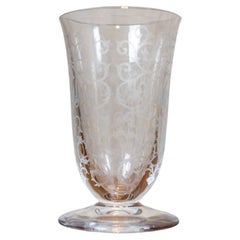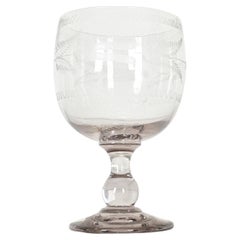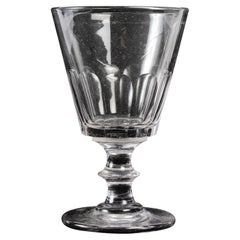Items Similar to Neoclassical Style Italian Chalice-Shaped Vase in Ground and Diamond Crystal
Want more images or videos?
Request additional images or videos from the seller
1 of 21
Neoclassical Style Italian Chalice-Shaped Vase in Ground and Diamond Crystal
$1,300.39
£970.30
€1,100
CA$1,809.32
A$2,024.67
CHF 1,053.26
MX$24,395.78
NOK 13,260.03
SEK 12,528.52
DKK 8,375.13
About the Item
Before describing the object under consideration, we must make an important clarification; the artifact, one of many that we will publish over time, is part of the museum collection of a historic Florentine crystal grinder that unfortunately closed recently. It is the Marcello Galgani & Son company, whose completely manual and artisanal work has not withstood the disproportionate advance of mass-produced mechanical processes! Marcello Galgani began his craft as a grinder and restorer in 1960; as the years went by, Marcello mastered and became familiar with particular techniques and shapes, resulting in the production of objects that manage to retain the freshness of grinding and engraving, the warmth and softness of light, and the inimitable flavor of unique artifacts. After several years, his son Lorenzo, who grew up among crystals, also entered the business and immediately became passionate about this ancient craft with skill and ability. Stimulated by the aesthetic sense of the past, father and son, set up a workshop in which the shapes they researched and created themselves are mouth-blown by traditional Tuscan glassmakers in Empoli, then ground and engraved using ancient sixteenth-century techniques, with motifs born from the Galgani's inexhaustible imagination or culturally inspired by designs of objects seen and studied in Florentine museums (Uffizi, Galleria Palatina, Museo degli Argenti, etc.). Marcello and Lorenzo Galgani were also Masters in the difficult art of restoration, bringing rare and precious objects back to life. As mentioned the company recently closed and disposed of all its last production, and only Marcello's old private museum collection remained, which includes unique and special objects created over time, a collection that the craftsman made available to us for a planned sale. All of the objects were made entirely by hand with old grinding wheels, but there were mainly two tools that allowed the creation of masterpieces: the right hand and the left hand of the master craftsman. Ancient glassmaking techniques were used for all the ground and engraved products: first, the object was ground with an emery wheel fed continuously by a jet of abrasive sand and water, then re-polished with a very fine-grained sandstone wheel also fed with water; the engravings were done freehand using as many as 10-15 small stone wheels for each design (flowers, branches, animals, etc. ); then the object was polished and shined; we must make, at this point, an important clarification on these last two operations: towards the end of the 1960s acid crystal polishing was devised, the object was immersed and rotated in a solution of sulfuric acid, fluoridic acid, and water and in a short time all the defects left by the previous processes were eliminated, it was a fast, industrial operation that allowed to lower costs considerably, with discrete but not excellent results. But for Galgani's products polishing is done with a cork bark wheel wet with water and pumice, to make the surfaces more transparent, and finally, polishing was achieved with a felt wheel wet with a paste of water, iron oxide, and cerium oxide. This series of processes takes an average of two days of work( sometimes much longer) for each object, each engraving or grinding is the result of the creative inventiveness of the two artisans, inventiveness that transforms crystal into reality material of the highest aesthetic value and inestimable value. All the items in the entire collection have never been used; they were part of the exhibition. Large crystal vase in the shape of a chalice with a smooth round base; the delicate and pleasant decorations are in Neoclassical style; but the most important part is the diamond part normally the diamond polishing was done by machine or a pre-printed diamond on the object was polished, on this vase it was done completely by hand with an extraordinary result! The object is "a unique piece" signed by the Master, it was executed in Marcello Galgani's workshop in 1985 and made with the techniques (grinding, engraving, and polishing) that we have explained in the introductory description; for the shape, the Master was inspired by some vases of ancient Bohemian manufacture preserved at the Bargello Museum in Florence, however, he personalized his vase creating a rare and precious object. Measures diameter cm.16, height cm.43. The vase is in excellent condition. For all our shipments we use special packaging materials (wooden crates, Styrofoam, etc.) for maximum protection and safety of the objects
- Dimensions:Height: 16.93 in (43 cm)Diameter: 6.3 in (16 cm)
- Style:Neoclassical (In the Style Of)
- Materials and Techniques:
- Place of Origin:
- Period:
- Date of Manufacture:1985
- Condition:The vase is in excellent condition. All the items in the entire collection have never been used; they were part of the exhibition.
- Seller Location:Prato, IT
- Reference Number:Seller: MG-1841stDibs: LU4632232183062
About the Seller
5.0
Platinum Seller
Premium sellers with a 4.7+ rating and 24-hour response times
Established in 1977
1stDibs seller since 2019
286 sales on 1stDibs
Typical response time: 1 hour
- ShippingRetrieving quote...Shipping from: PRATO, Italy
- Return Policy
Authenticity Guarantee
In the unlikely event there’s an issue with an item’s authenticity, contact us within 1 year for a full refund. DetailsMoney-Back Guarantee
If your item is not as described, is damaged in transit, or does not arrive, contact us within 7 days for a full refund. Details24-Hour Cancellation
You have a 24-hour grace period in which to reconsider your purchase, with no questions asked.Vetted Professional Sellers
Our world-class sellers must adhere to strict standards for service and quality, maintaining the integrity of our listings.Price-Match Guarantee
If you find that a seller listed the same item for a lower price elsewhere, we’ll match it.Trusted Global Delivery
Our best-in-class carrier network provides specialized shipping options worldwide, including custom delivery.More From This Seller
View AllNeoclassical Style Italian Crystal Vase With Festoon Engravings
Located in Prato, Tuscany
Before describing the object under consideration we must make an important clarification; the artifact, one of many that we will publish over time, is part of the museum collection of a historic Florentine crystal grinder that unfortunately closed recently. It is the Marcello Galgani & Son company, whose completely manual and artisanal work has not withstood the disproportionate advance of mass-produced mechanical processes! Marcello Galgani began his craft as a grinder and restorer in 1960; as the years went by, Marcello mastered and became familiar with particular techniques and shapes, resulting in the production of objects that manage to retain the freshness of grinding and engraving, the warmth and softness of light, and the inimitable flavor of unique artifacts. After several years, his son Lorenzo, who grew up among crystals, also entered the business and immediately became passionate about this ancient craft with skill and ability. Stimulated by the aesthetic sense of the past, father and son, set up a workshop in which the shapes they researched and created themselves are mouth-blown by traditional Tuscan glassmakers in Empoli, then ground and engraved using ancient sixteenth-century techniques, with motifs born of the Galgani's inexhaustible imagination or culturally inspired by designs of objects seen and studied in Florentine museums (Uffizi, Galleria Palatina, Museo degli Argenti, etc.). Marcello and Lorenzo Galgani were also Masters in the difficult art of restoration, bringing rare and precious objects back to life. As mentioned the company recently closed and disposed of all its last production, only Marcello's old private museum collection remained, which includes unique and special objects created over time, a collection that the craftsman made available to us for a planned sale. All of the objects were made entirely by hand with old grinding wheels, but there were mainly two tools that allowed the creation of masterpieces: the right hand and the left hand of the master craftsman. Ancient glassmaking techniques were used for all the ground and engraved products: first the object was ground with an emery wheel fed continuously by a jet of abrasive sand and water, then re-polished with a very fine-grained sandstone wheel also fed with water; the engravings were done freehand using as many as 10-15 small stone wheels for each design (flowers, branches, animals, etc. ); then the object was polished and shined; we must make, at this point, an important clarification on these last two operations: towards the end of the 1960s acid crystal polishing was devised, the object was immersed and rotated in a solution of sulfuric acid, fluoridic acid and water and in a short time all the defects left by the previous processes were eliminated, it was a fast, industrial operation that allowed to lower costs considerably, with discrete but not excellent results. But for Galgani's products polishing is done with a cork bark wheel wet with water and pumice, to make the surfaces more transparent. Finally, polishing was achieved with a felt wheel wet with a paste of water, iron oxide, and cerium oxide. This series of processes takes an average of two days of work( sometimes much longer) for each object, each engraving or grinding is the result of the creative inventiveness of the two craftsmen, inventiveness that transforms crystal into a material reality of the highest aesthetic value and inestimable value. All objects in the entire collection have never been used; they were part of the exhibition. Large oval crystal vase...
Category
Late 20th Century Italian Neoclassical Vases
Materials
Crystal
Florentine Renaissance Style Huge Italian Cut And Ground Crystal Medici Vase
Located in Prato, Tuscany
Before describing the object under consideration, we must make an important clarification; the artifact, one of many that we will publish over time, is part of the museum collection of a historic Florentine crystal grinder that unfortunately closed recently. It is the Marcello Galgani & Son company, whose completely manual and artisanal work has not withstood the disproportionate advance of mass-produced mechanical processes! Marcello Galgani began his craft as a grinder and restorer in 1960; as the years went by, Marcello mastered and became familiar with particular techniques and shapes, resulting in the production of objects that manage to retain the freshness of grinding and engraving, the warmth and softness of light, and the inimitable flavor of unique artifacts. After several years, his son Lorenzo, who grew up among crystals, also entered the business and immediately became passionate about this ancient craft with skill and ability. Stimulated by the aesthetic sense of the past, father and son, set up a workshop in which the shapes they researched and created themselves are mouth-blown by traditional Tuscan glassmakers in Empoli, then ground and engraved using ancient sixteenth-century techniques, with motifs born from the Galgani's inexhaustible imagination or culturally inspired by designs of objects seen and studied in Florentine museums (Uffizi, Galleria Palatina, Museo degli Argenti, etc.). Marcello and Lorenzo Galgani were also Masters in the difficult art of restoration, bringing rare and precious objects back to life. As mentioned the company recently closed and disposed of all its last production, and only Marcello's old private museum collection remained, which includes unique and special objects created over time, a collection that the craftsman made available to us for a planned sale. All of the objects were made entirely by hand with old grinding wheels, but there were mainly two tools that allowed the creation of masterpieces: the right hand and the left hand of the master craftsman. Ancient glassmaking techniques were used for all the ground and engraved products: first, the object was ground with an emery wheel fed continuously by a jet of abrasive sand and water, then re-polished with a very fine-grained sandstone wheel also fed with water; the engravings were done freehand using as many as 10-15 small stone wheels for each design (flowers, branches, animals, etc. ); then the object was polished and shined; we must make, at this point, an important clarification on these last two operations: towards the end of the 1960s acid crystal polishing was devised, the object was immersed and rotated in a solution of sulfuric acid, fluoridic acid and water and in a short time all the defects left by the previous processes were eliminated, it was a fast, industrial operation that allowed to lower costs considerably, with discrete but not excellent results. But for Galgani's products polishing is done with a cork bark wheel wet with water and pumice, to make the surfaces more transparent, and finally polishing was achieved with a felt wheel wet with a paste of water, iron oxide, and cerium oxide. This series of processes takes an average of two days of work( sometimes much longer) for each object, each engraving or grinding is the result of the creative inventiveness of the two artisans, inventiveness that transforms crystal into reality material of the highest aesthetic value and inestimable value. All the items in the entire collection have never been used; they were part of the exhibition. Huge and monumental Florentine Renaissance-style vase...
Category
Late 20th Century Italian Renaissance Vases
Materials
Crystal
Yeoward William “Collection Crystal” English Goblet
By William Yeoward
Located in Prato, Tuscany
We kindly suggest you read the whole description, because with it we try to give you detailed technical and historical information to guarantee the authenticity of our objects. We have two other goblets identical to this one that we sell in pairs (posted on 1stdibs)
Iconic and precious crystal chalice; it has been made from the highest quality lead crystal with a thickness that is thick enough to allow it to be ground deeper than normal, which allows the light to reflect in a much brighter and more brilliant manner; for this to happen, the geometry of the grinding has also been specially designed and executed. The glass is a delightful combination of intricate cuts and engravings and features some of the most beautiful motifs of the 18th and 19th centuries. Every detail of the decoration, such as the glittering star wheel, is cut entirely by hand, with hours of specialized labor required to complete each piece in the collection achieving a very high standard of quality. The glass was made in London, England, between 1995 and 1996 by the William Yeoward company, whose name it bears on the bottom (see photo), and is one of the most attractive designs in the "William Yeoward Crystal...
Category
Late 20th Century British Neoclassical Crystal Serveware
Materials
Crystal
Neoclassical Style Large Italian Crystal Vase with 18th Century Engravings
Located in Prato, Tuscany
Before describing the object under consideration, we must make an important clarification; the artifact, one of many that we will publish over time, is part of the museum collection of a historic Florentine crystal grinder that unfortunately closed recently. It is the Marcello Galgani & Son company, whose completely manual and artisanal work has not withstood the disproportionate advance of mass-produced mechanical processes! Marcello Galgani began his craft as a grinder and restorer in 1960; as the years went by, Marcello mastered and became familiar with particular techniques and shapes, resulting in the production of objects that manage to retain the freshness of grinding and engraving, the warmth and softness of light, and the inimitable flavor of unique artifacts. After several years, his son Lorenzo, who grew up among crystals, also entered the business and immediately became passionate about this ancient craft with skill and ability. Stimulated by the aesthetic sense of the past, father and son, set up a workshop in which the shapes they researched and created themselves are mouth-blown by traditional Tuscan glassmakers in Empoli, then ground and engraved using ancient sixteenth-century techniques, with motifs born from the Galgani's inexhaustible imagination or culturally inspired by designs of objects seen and studied in Florentine museums (Uffizi, Galleria Palatina, Museo degli Argenti, etc.). Marcello and Lorenzo Galgani were also Masters in the difficult art of restoration, bringing rare and precious objects back to life. As mentioned the company recently closed and disposed of all its last production, and only Marcello's old private museum collection remained, which includes unique and special objects created over time, a collection that the craftsman made available to us for a planned sale. All of the objects were made entirely by hand with old grinding wheels, but there were mainly two tools that allowed the creation of masterpieces: the right hand and the left hand of the master craftsman. Ancient glassmaking techniques were used for all the ground and engraved products: first, the object was ground with an emery wheel fed continuously by a jet of abrasive sand and water, then re-polished with a very fine-grained sandstone wheel also fed with water; the engravings were done freehand using as many as 10-15 small stone wheels for each design (flowers, branches, animals, etc. ); then the object was polished and shined; we must make, at this point, an important clarification on these last two operations: towards the end of the 1960s acid crystal polishing was devised, the object was immersed and rotated in a solution of sulfuric acid, fluoridic acid and water and in a short time all the defects left by the previous processes were eliminated, it was a fast, industrial operation that allowed to lower costs considerably, with discrete but not excellent results. But for Galgani's products polishing is done with a cork bark wheel wet with water and pumice, to make the surfaces more transparent, and finally polishing was achieved with a felt wheel wet with a paste of water, iron oxide, and cerium oxide. This series of processes takes an average of two days of work( sometimes much longer) for each object, each engraving or grinding is the result of the creative inventiveness of the two artisans, inventiveness that transforms crystal into reality material of the highest aesthetic value and inestimable value. All the items in the entire collection have never been used; they were part of the exhibition. Large crystal vase with base; the decorations, graceful and delicate, are in Neoclassical style. The object is "one-of-a-kind" signed by the Master; it was created in Marcello Galgani's workshop in 1981 and made with the techniques (grinding, engraving, and polishing) we explained in the description; for the shape, the Master was inspired by a vase found in a painting, preserved in the Uffizi Gallery in Florence by the 16th-century painter Jacopo Ligozzi...
Category
Late 20th Century Italian Neoclassical Vases
Materials
Crystal
Baroque Style Large Italian Crystal Vase With Grotesque Engravings
Located in Prato, Tuscany
Before describing the object under consideration, we must make an important clarification; the artifact, one of many that we will publish over time, is part of the museum collection of a historic Florentine crystal grinder that unfortunately closed recently. It is the Marcello Galgani & Son company, whose completely manual and artisanal work has not withstood the disproportionate advance of mass-produced mechanical processes! Marcello Galgani began his craft as a grinder and restorer in 1960; as the years went by, Marcello mastered and became familiar with particular techniques and shapes, resulting in the production of objects that manage to retain the freshness of grinding and engraving, the warmth and softness of light, and the inimitable flavor of unique artifacts. After several years, his son Lorenzo, who grew up among crystals, also entered the business and immediately became passionate about this ancient craft with skill and ability. Stimulated by the aesthetic sense of the past, father and son, set up a workshop in which the shapes they researched and created themselves are mouth-blown by traditional Tuscan glassmakers in Empoli, then ground and engraved using ancient sixteenth-century techniques, with motifs born from the Galgani's inexhaustible imagination or culturally inspired by designs of objects seen and studied in Florentine museums (Uffizi, Galleria Palatina, Museo degli Argenti, etc.). Marcello and Lorenzo Galgani were also Masters in the difficult art of restoration, bringing rare and precious objects back to life. As mentioned the company recently closed and disposed of all its last production, and only Marcello's old private museum collection remained, which includes unique and special objects created over time, a collection that the craftsman made available to us for a planned sale. All of the objects were made entirely by hand with old grinding wheels, but there were mainly two tools that allowed the creation of masterpieces: the right hand and the left hand of the master craftsman. Ancient glassmaking techniques were used for all the ground and engraved products: first, the object was ground with an emery wheel fed continuously by a jet of abrasive sand and water, then re-polished with a very fine-grained sandstone wheel also fed with water; the engravings were done freehand using as many as 10-15 small stone wheels for each design (flowers, branches, animals, etc. ); then the object was polished and shined; we must make, at this point, an important clarification on these last two operations: towards the end of the 1960s acid crystal polishing was devised, the object was immersed and rotated in a solution of sulfuric acid, fluoridic acid and water and in a short time all the defects left by the previous processes were eliminated, it was a fast, industrial operation that allowed to lower costs considerably, with discrete but not excellent results. But for Galgani's products polishing is done with a cork bark wheel wet with water and pumice, to make the surfaces more transparent, and finally polishing was achieved with a felt wheel wet with a paste of water, iron oxide, and cerium oxide. This series of processes takes an average of two days of work( sometimes much longer) for each object, each engraving or grinding is the result of the creative inventiveness of the two artisans, inventiveness that transforms crystal into reality material of the highest aesthetic value and inestimable value. All the items in the entire collection have never been used; they were part of the exhibition. Large crystal vase; the decorations, in baroque style represent a series of "grotesques" The object is "a unique piece" signed by the Master, it was created in Marcello Galgani's workshop in 1983 and made with the techniques (grinding, engraving and polishing) that we explained in the description; for the shape, the Master was inspired by a vase present in a painting, preserved in the Uffizi Gallery in Florence by the sixteenth-century painter Jacopo Ligozzi...
Category
Late 20th Century Italian Baroque Vases
Materials
Crystal
Biedermeier Style Bohemia Cut And Ground Red Crystal Vase
Located in Prato, Tuscany
We kindly suggest that you read the entire description, as with it we try to give you detailed technical and historical information to ensure the authenticity of our objects.
Delight...
Category
Mid-20th Century Czech Biedermeier Vases
Materials
Crystal
You May Also Like
Neoclassical Cut Crystal and 1000 Silver Urn Vase
Located in Barcelona, ES
Impressive cut crystal urn-vase standing on silver/1000 base. Italy, 1930-1940s
This Neoclassical urn vase was manufacturet at the Art Deco period.
Finely executed with very detailed...
Category
20th Century Italian Neoclassical Vases
Materials
Crystal, Silver
20th-Century Crystal Cup with Arabesque
Located in Opole, PL
20th-Century Crystal Cup with Arabesque
We present a cup with the cut motif of arabesque.
It was manufactured after 1945.
This item is in particularly go...
Category
20th Century French Glass
Materials
Crystal
$283 Sale Price
20% Off
French 19th Century Etched Glass Chalice
Located in Baton Rouge, LA
Lovely hand rolled and mouth blown clear glass chalice–or vase–from France, 19th century. The tulip-shaped footed bowl is smooth on the interior and etched by hand in stylized motifs...
Category
Antique 19th Century French Other Crystal Serveware
Materials
Glass
Cut Crystal Cup or Small Vase
Located in Saint-Ouen, FR
A cut crystal cup or small vase, 19th century, Napoleon III period.
Measures: H: 18 cm, D: 11 cm.
Category
Antique 19th Century European Napoleon III Crystal Serveware
Materials
Crystal
Vintage Vase Bohemian Crystal Diamond Pattern Medici 23cm
Located in Poperinge, BE
Vintage transparent vase made of Bohemian lead crystal, the vase has beautiful diamond patterns and is made in the shape of a Medici urn, Eastern European, circa mid 20th century.
B...
Category
Mid-20th Century Czech Vases
Materials
Crystal
Spanish Art Deco Cut Crystal and Silver Urn Vase
Located in Barcelona, ES
Cut crystal vase with silver base, Spain, 1930s-1940s.
Elegant urn shaped crystal vase manufactured at the late Art Deco period.
Finely executed with very detailed hand-cut crystal patterns...
Category
20th Century Spanish Art Deco Vases
Materials
Crystal, Silver
More Ways To Browse
Ancient Crystals
Crystal Flower Vases
Chalice Italy
Jet Stone
Polish Crystal Vases
Round Crystal Vase
Vintage Crystal Flower Vase
Bohemian Vase Flowers
Very Large Crystal Vase
Paste Diamonds
Stone Wheel
Bark Vases
Bohemian Crystal Vases
Vintage Diamond Tools
Florentine Vase
Florentine Italy Vases And
Chalice Used
Tuscan Vase
